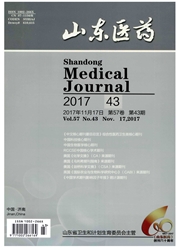

 中文摘要:
中文摘要:
目的探讨抗原激发后骨髓祖细胞造血因子受体IL-5Rα、CCR3表达及与哮喘气道原位造血的关系。方法将C57BL/6小鼠随机分为对照组、模型组及地塞米松组各20只,后两组以卵白蛋白(OVA)致敏和激发建立哮喘模型,地塞米松组于抗原激发前经腹腔注射地塞米松。于最后一次抗原激发后48 h测气道反应性,检测骨髓CD3+4祖细胞IL-5Rα mRNA、CCR3表达;观察造血因子受体对祖细胞净迁移率及嗜酸性粒细胞(Eos)克隆形成的影响。结果与对照组比较,模型组IL-5Rα mRNA和CCR3表达显著上调,CD3+4祖细胞净迁移率及Eos细胞克隆数明显增加(P均〈0.05)。与模型组比较,地塞米松组IL-5Rα mRNA、CCR3表达明显下调,CD3+4祖细胞净迁移率及Eos细胞克隆数明显减少(P均〈0.05),气道反应性及气道Eos浸润相应明显减轻(P均〈0.05)。结论哮喘小鼠IL-5Rα mRNA、CCR3表达与哮喘气道原位造血关系密切;地塞米松干预可抑制IL-5Rα mRNA和CCR3表达,抑制气道原位造血,减轻气道Eos炎症和气道高反应性。
 英文摘要:
英文摘要:
Objective To investigate the relationship between the haemopoietic cytokine receptor IL-5Rα and CCR3 expression on progenitors after the excitation of antigen and the in situ differentiation of allergic airway.Methods C57BL/6 mice were randomly divided into control group,model group and dexamethasone group with 20 in each.The model group and the dexamethasone group were sensitized and challenged with ovalbumin(OVA) to establish asthmatic model.The dexamethasone group was injected with dexamethasone before OVA challenge.The airway responsiveness was measured 48 hs after the final challenge.Then the IL-5Rα mRNA and CCR3 expression were detected.The effect of haemopoietic cytokine receptor to the migration and colony-forming were observed.Results The expression of IL-5Rα mRNA and CCR3 on CD+34 progenitors,the migration of progenitors,and the number of Eos-CFU were significantly up-regulated in model group compared with those in control group.However,administration with dexamethasone in vivo significantly inhibited the expression of CCR3 and IL-5Rα mRNA,effectively reduced the migration of progenitors and reduced the number of Eos-CFU(all P0.05),reduced airway hyperreactivity and effectively ablated pulmonary eosinophilia compared with the model group(all P0.05).Conclusion The expression of IL-5Rα mRNA and CCR3 play a potent role in the migration and in situ differentiation of CD+34 progenitors in airway of allergic mice.Administration with dexamethasone in vivo can inhibit the expression of CCR3 and IL-5Rα mRNA on CD+34 progenitors and exert suppressive effects on the in situ differentiation of eosinophil progenitors in allergic inflammation context,and can reduce airway hyperreactivity and ablate pulmonary eosinophilia induced by allergen challenge.
 同期刊论文项目
同期刊论文项目
 同项目期刊论文
同项目期刊论文
 CCR3 monoclonal antibody inhibits airway eosinophilic inflammation and mucus overproduction in a mou
CCR3 monoclonal antibody inhibits airway eosinophilic inflammation and mucus overproduction in a mou 期刊信息
期刊信息
